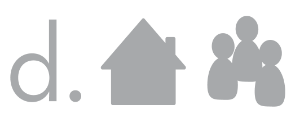Challenging our Assumptions
Teams share out their “choose your own adventure” dining experience.
Redefining Define
The third session focused on challenging assumptions and the levers for change as tools for narrowing and defining a challenge. Our group started their day having breakfast together in a restaurant, but of course we weren’t just there for the food! After completing their meal the participants identified the assumptions that they had unknowingly made about what it means to eat a meal in a restaurant (i.e. waiting for a table is not a particularly fun part of the meal.).
Next we introduced the five levers for change: time, space, roles, rituals and objects. The participants looked at their own assumptions and either flipped them (Waiting to be seated is super annoying -> The wait is so fantastic that it draws more customers) or made them more extreme. The favorite ideas were selected and developed into prototypes, which we then tested with the group.
Onsite Prototypes
Prototyping onsite led to some fantastic ideas. One group worked on improving the waiting experience at a restaurant. They took the assumption that waiting is inconvenient, boring, crowded and uncomfortable and flipped the assumption to make the waiting itself an experience that is fun and part of the draw of coming to the restaurant in the first place by creating a huge, fun waiting area.
Another team came up with the idea of being able to choose your own seat in a restaurant (expanding the assumption that you sit in chairs that are provided for you). Upon hearing this idea, one of our facilitators immediately ran across the street to the gym and borrowed a big exercise ball and other yoga and exercise equipment for a variety of seats. We had a very enthusiastic group and had fun going all out and making the workshop spontaneous and fun.
It was a creative day of prototyping onsite and lots of good ideas not only came out of the workshop but were also brought back to the schools of the workshop participants.
Taking it Home
Participants get feedback: on their dining concierge experience.
At both sites our participants asked for more time to work on how to bring their ideas home. We gave them about 30 minutes to plan near the end of the day and they came up with some fantastic ideas!
Mix things up!
One team started with the realization that their school cafeteria was static. The set up hadn’t been shifted in 20 years. Everyone sits in the same place every day. They decided to turn all of the tables to a diagonal when they returned to school after the workshop and see how it shifted the experience for the kids when they enter the cafeteria the next day at school. The following Monday the new changes were implemented and team members saw an immediate change in the student’s behavior. “I can actually see the other students in the room!” ~elementary school student
Chit Chat
Another participant wanted to make the first ten minutes of class more valuable. She was frustrated because she felt that the beginning of class is always wasted with socializing among her students. She flipped this assumption upside down and decided that instead of looking at it as a waste, she would look at the time her students spent socializing as valuable. She developed a prototype to create a productive structured social time to begin each class with.
The Most Important Meal of the Day
It was fantastic to have an authentic experience for our participants and it added some fun new dynamics and challenges.
Challenges
Space is everything!
During the Colorado workshops we used two different restaurants for our two groups. One of the restaurants we worked with had a fantastic space but was brand new and was not yet running smoothly. During the second workshop, we were at a more established restaurant and while it ran smoother, we were confined to a private room that detracted from the authentic restaurant experience. Overall, it seemed that having a flexible authentic space had the most positive impact on the experience.
Adapt it: One possible solution to troubleshoot some of the challenges we faced in regards to logistics and cost would be to hold this workshop in a really creative, fun space but have it catered which may simplify some of the logistics we faced working with the restaurants (such as overly complicated menus, higher costs to run the workshop, or the meals taking much longer than we hoped) while still providing the participants a restaurant-like authentic experience.


